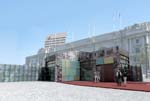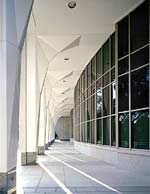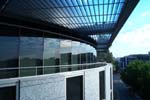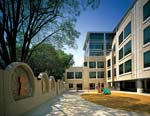

Home Site Search Contact Us Subscribe
|
|
|
|
Sustainable Urbanism Tops the Agenda as World Environment Day Comes to the U.S. June 1-5
As sustainable design champions put the pedal to the scrap metal, they've got their eye on the distant prize - sustainable urbanism. They want your buy-in. They want it now. by Sharon Tucker May 31, 2005 Green building advocates are working down to the wire to ensure a high profile for sustainable design during the World Environment Day (WED) conference in San Francisco June 1-5. The week-long series of tours, talks, exhibits, and activities will mix celebration and education. A project of the United Nations Environment Program (UNEP) and first held in 1972, this year’s event is taking place in the United States for the first time.
It is also the first such conference to focus on the urban environment. In another first, San Francisco Mayor Gavin Newsom embraced a larger public agenda by inviting mayors from around the world to join him at the conference. As many as 125 mayors from urban centers as diverse as Kabul, London, and Southern California plan to attend to share challenges as well as best practices.
“Redesigning the Metropolis” is the theme for urban design events, clustered largely on June 2, that will focus on a number of environmental and ecological issues. Thousands of citizens are expected to participate in more than 250 public-interest activities this week.
Reconnecting with sustainability principles
Mayor Newsom tapped the city’s Department of the Environment to co-host the conference. “We want to raise the general public’s awareness of green building, here and elsewhere, and then mainstream it,” says Mark Palmer, the department’s Green Building Coordinator.
AIA San Francisco members and others in the Bay Area design community have been working for months to plan events that will raise awareness of sustainable building among their peers as well as the public. Sustainable design advocates are also eager to hear from the contingent of mayors about their challenges and successes. “The sad truth,” says AIA SF Executive Director Margie O’Driscoll, “is that many European countries have employed green building codes for years, and American cities, even San Francisco, lag far behind.”
AIA SF will sponsor green building tours and other events and, its “Going Green” exhibit will showcase AIA Committee on the Environment (COTE) Top 10 winners at the chapter gallery. The chapter is also expanding and greening its own headquarters in the historic Hallidie Building with the intent to qualify for a U.S. Green Building Council (USGBC) Leadership in Energy & Environmental Design (LEED) rating of silver or gold. Richard Parker, AIA, Principal, 450 architects, who has led AIA SF planning efforts for the conference, comments, “My hope is that the public will gain a broader understanding of green building and that architects will reconnect with sustainable design principles they already know. We can’t continue to say ‘expense is the problem.’”
Putting the pedal to the scrap metal
The week’s most adventurous undertaking is the ScrapHouse, being “blitz-built” entirely from salvaged materials over the mad course of 16 days, beginning on a vacant lot under the Bay Bridge and then hauled in pieces to a site at the edge of the San Francisco Civic Center. This elegant, 500-square-foot, single family demonstration home is a collaborative effort of more than four dozen Bay Area architects, engineers, contractors, artists, and city officials.
Sponsored by Public Architecture, a public-interest non-profit, the project illustrates the ongoing life-span of discarded or junked materials. “It’s all transitional. It won’t be what it’ll be until it’s built,” says John Peterson, AIA, Principal, Peterson Architects. As chairman of Public Architecture, he leads the ScrapHouse design team. Peterson cites a few features already underway – wainscoting made from open phone books (white pages only!), kitchen cabinets made from wine boxes, a rippling wall surface constructed solely of molding strips. The front yard continues the theme – flowers salvaged daily from the city’s Flower Mart will be inserted into bud vases made from garden hose. Construction is being shown live via webcam – dubbed the “scrapcam,” naturally. The ScrapHouse will be open to the public, June 2-5; its future thereafter is still unknown, but the imaginative team has plenty of ideas, and none of them involves scraping the ScrapHouse.
A number of firms, including Gensler, HOK, Levy Art & Architecture, and Swinerton, Inc., will participate in “Building on Experience,” opening their doors for an hour or two to display and discuss innovative green building strategies and plans for various building types. EDAW will host a panel review of the regenerative power of parks. Meantime, a sustainable office building on wheels will cruise the streets, stopping to demonstrate green building design materials and systems promoted by the USGBC. LEED green building training workshops will be conducted throughout the week. Other Bay Area architects scheduled to speak during the conference include Anthony Bernheim, FAIA, Principal, SMWM, and Peter Calthorpe, Principal, Calthorpe Associates.
As all these sustainable design champions put the pedal to the scrap metal, 450 architects’ Parker sees an opportunity for more of the region’s urban planners and design community to become engaged in the multiple issues that combine to define urban life. “If not here in San Francisco, where?” he asks. The wealth and the will, coupled with the Bay Area’s long history of eco-awareness and innovation, mandate that involvement, he believes.
Urban Environmental Accords
The centerpiece of the conference is its Urban Environmental Accords, which set out ways to improve cities’ livability through interconnected policies relating to urban design, urban nature, transportation, energy, waste reduction, environmental health, and water. Drafted in a participatory process involving many hands, the document will be signed by mayors at the conclusion of the conference.
Conceived as a seven-year action plan, the accords seek “to build an ecologically sustainable, economically dynamic, and socially equitable future for our cities.” Framers looked for “common-sense solutions for common problems.” Specifics are based on existing and emerging best practices. It is expected that the accords will call for mayors to: mandate a green rating system for municipal buildings; work toward higher-density, mixed-use planning; and ensure open space nearby every city resident.
SPUR (San Francisco Planning and Urban Research Association) has organized a number of events in June to showcase sustainable urbanism. “San Franciscans have a high environmental consciousness, but we haven’t translated it into a different form of urbanism,” says SPUR Deputy Director Gabriel Metcalfe. “What will matter to us, and to history, is that the (WED) accords commit cities to take steps to change the way citizens live on the planet.”
Mark Palmer at San Francisco’s Department of the Environment has high expectations for the future exchange of programmatic and technological information. Set up in 1996, the department lagged behind several other cities in setting green standards for municipal building construction. But Palmer says San Francisco leads the way with its green building pilot projects, which pack as much green design as possible into large-scale public-private construction. The most visible example is the California Academy of Sciences, designed by Renzo Piano in collaboration with Chong Partners and scheduled to open in 2008 – and aiming for a LEED Platinum rating. “We’ll enjoy showing what San Francisco is doing well,” Palmer says, “but what we really hope is to learn from others and examine practices that work elsewhere.”
AIA SF’s O’Driscoll agrees. She hopes that “the international attention focused on San Francisco during WED will help spur our leaders and friends to continue the momentum.”
Illustrating sustainable urbanism
The week’s mix of activities is unfathomably rich. Neighborhood tours will illustrate urbane density and infill strategies. The San Francisco Port will showcase waterfront redevelopment. Hayes Valley neighbors will welcome an ornate but transitory temple, built from surplus wood by sculptor David Best, on its new Hayes Green. Walking tours of parks, TODs (transit-oriented developments), and public utility infrastructure will occur throughout the Bay Area. Other tours will examine polluted neighborhoods and the social injustice that spawns them. And there’s more. An overview of green building case studies. A visit to the 15,000-acre salt pond restoration project in South San Francisco Bay. Extensive public outreach about residential green building. An update on Califia, the long-proposed ecological city of the future. Sustainable schools strutting their green stuff. Demonstrations of bio-fuels and solar technologies, including a view of the Moscone Center’s 675 kw solar electric rooftop, among the largest of its kind in the country.
Other building-related events officially connected with the conference, or serendipitously occurring at the same time, include:
Beyond sustainable urbanism and the green building agenda, the week demonstrates affinity marketing in its glory. There’ll be something green for everybody, from “urban jungle environmental art” to a wowser eco-chic fashion show.
But perhaps the most keenly anticipated tangential venue of them all will beckon from deep inside Hawk Hill just across Golden Gate Bridge from the city. In a World War II-era tunnel beneath the Marin Headlands, two starlight “transformance” concerts (June 4) will feature a didgeridoo master and a Tuvan throat singer.
And there you have it, in all its varietals. In San Francisco at least, green is the new black.
Sharon Tucker, Tucker Elie communication, works with business leaders who have something substantive to say and want to say it well. |
(click on pictures to enlarge)  (Sean Ahlquist, process 2 design, ©2005, Public Architecture) Rendering of the ScrapHouse, being "blitz-built" from salvaged materials, in its temporary site at San Francisco’s Civic Center (California Academy of Sciences / Renzo Piano Building Workshop / Chong Partners) Watercolor of California Academy of Sciences' “living roof” within its Golden Gate Park setting; architects: Renzo Piano Building Workshop/Chong Partners (California Academy of Sciences / Renzo Piano Building Workshop / Chong Partners) Aerial view of the Academy of Sciences, which fronts the Music Concourse in Golden Gate Park (California Academy of Sciences / Renzo Piano Building Workshop / Chong Partners) Elevation looking east from the site the Academy of Sciences has occupied since 1916 (California Academy of Sciences / Renzo Piano Building Workshop / Chong Partners) The cutaway shows how the two biggest hills in the “living roof” will accommodate a four-story living rainforest and a state-of-the-art planetarium (California Academy of Sciences / Renzo Piano Building Workshop / Chong Partners) Section shows piazza and “living roof” of the Academy of Sciences (California Academy of Sciences / Renzo Piano Building Workshop / Chong Partners) Solar panels line the outside rim of the roof above the entrance; natural sunlight from the piazza will nourish a 225,000-gallon coral reef display (Erhard Pfeiffer) Capital Area East End Complex (CAEEC): one of the greenest office buildings in California includes an outdoor arcade that provides shade during Sacramento’s hot summers; design/build team: Johnson Fain Architects, Fentress Bradburn, SMWM, Dreyfuss & Blackford, Hensel Phelps Construction Co. (SMWM) CAEEC: sun shades and high performance glazing help reduce heat gain and loss (Erhard Pfeiffer) CAEEC: onsite full-service daycare provides both indoor and outdoor spaces for children (Sharon Risedorph) Argonne Child Development Center: photovoltaic collectors and preserved open space are among the award-winning project’s green strategies; architect: 450 architects (Sharon Risedorph) Argonne Center: small reading rooms enable children at the to be close to the sights and smells of an adjacent community garden, the largest in San Francisco (J.D. Peterson) Environmentally conscious flagship store interior for Japanese Weekend by 450 architects |
© 2005 ArchNewsNow.com